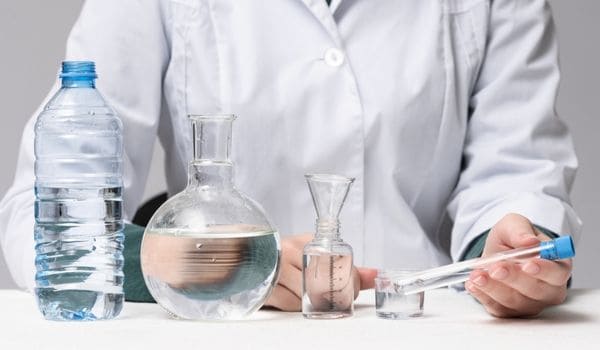If you’ve heard that charcoal filters can remove lead from tap water, you’re not alone. But is it true—or just another water filter myth?
The short answer: some carbon filters can remove lead—but not all. And if you’re banking on that cheap pitcher in the fridge to protect your family from heavy metals, it might be time for a closer look.
Let’s break down how carbon works, when it’s effective, and what to watch out for before you buy.
💡 Quick Takeaways
- 🧪 Not all activated carbon filters remove lead—check for NSF certification
- 🧱 Carbon block filters usually outperform loose GAC systems
- 💧 Some carbon filters can remove up to 99% of lead—others barely scratch the surface
- 🧾 Filter quality and maintenance are just as important as the media itself
- 🔍 Testing your water is the only way to know if you’re targeting the right problem
- 🚰 Reverse osmosis may be a better choice if your lead levels are high
🚿 How Does This Contaminant End Up in Your Water?
Lead isn’t something utilities add to your water—it usually gets in through old pipes and plumbing parts. Homes built before the 1980s often have aging service lines, soldered joints, or fixtures that can leach this heavy metal right into your drinking water.
Even newer homes aren’t always immune—especially if you have older faucets or unfiltered supply lines.
🔎 Here’s how to tell if your tap water might be at risk.
🧠 How Carbon Filters Actually Work

Activated carbon doesn’t filter like a screen—it works more like a sponge.
Each tiny particle is full of nooks and crannies that trap contaminants through a process called adsorption (yep, that’s with a “d”). As water flows through, chemicals and particles cling to the surface and stay behind.
The result? Cleaner, better-tasting water—if the filter is up to the task.
💡 One gram of activated carbon can have a surface area of over 30,000 square feet. That’s like filtering water through a tennis court.
💧 Can Activated Carbon Filters Remove This Contaminant?
Yes—some can. But here’s the catch: not all carbon filters are built the same.
The basic ones (like what you find in a fridge or budget pitcher) might reduce a little—maybe 10% to 40%. But high-performance carbon filters can remove up to 99% of this harmful heavy metal.
So what’s the difference?
- 🟫 Carbon quality: Coconut shell carbon offers better density and porosity
- 🔳 Filter type: Carbon block filters trap more than loose GAC filters
- 📜 Certification: Look for filters certified under NSF/ANSI Standard 53
✅ This system from SpringWell is one of the top-performing whole-house carbon filters we’ve reviewed for reducing toxins like lead and cysts.
🔬 Not All Carbon Filters Work the Same

There’s more than one type of activated carbon—and they don’t all perform equally when it comes to removing heavy metals.
Some prioritize speed, others maximize contact time. A few are chemically enhanced to target trickier contaminants. Here’s how the main types compare:
🧪 Comparison of Activated Carbon Filter Types
| 🧱 Filter Type | ✅ Strengths | ⚠️ Limitations |
|---|---|---|
| Granular Activated Carbon (GAC) | Fast flow Often used in pitchers & fridge filters |
Lower contact time = less lead reduction |
| Carbon Block | Slower flow Better for heavy metal removal |
May reduce water pressure slightly |
| Catalytic Carbon | Chemically enhanced Targets tricky contaminants like chloramines |
Higher cost Not always needed for basic lead removal |
🧠 Good to Know: If you’re choosing between options, carbon block filters made from coconut shell offer the best balance of affordability and lead reduction—especially when NSF-certified.
🚫 What Activated Carbon Can’t Catch

While activated carbon filters are versatile, they’re not miracle workers. Here’s what they typically don’t remove:
- ❌ Fluoride
- ❌ Hard minerals (like calcium and magnesium)
- ❌ Some dissolved heavy metals (like arsenic)
- ❌ Microorganisms (bacteria, viruses, parasites)
That doesn’t mean they’re ineffective—just that they have limits.
🧼 If your water is biologically unsafe or contains tricky contaminants like fluoride or arsenic, you’ll need a different kind of treatment—like reverse osmosis or UV purification.
💡 When to Consider Reverse Osmosis Instead

If your water has elevated levels of lead or a mix of other stubborn contaminants, a reverse osmosis (RO) system might be the smarter choice.
RO filters work differently—they push water through a membrane with microscopic pores that block nearly everything except H₂O molecules.
Why choose RO over carbon?
- Removes more lead (up to 99%)
- Blocks fluoride, nitrates, arsenic, and more
- Often paired with a carbon pre-filter for added protection
The tradeoff? It’s slower and usually limited to one faucet.
🧪 Want to Know If You Need a Filter? Test First.

You can’t see or taste lead in water—and most contamination happens after the water leaves your local treatment plant.
That’s why testing isn’t optional. It’s the only way to know if your home plumbing is contributing to the problem.
Your options:
- 🧻 DIY test strips: Cheap, but not always accurate
- 🧪 Lab-based kits: More precise and personalized
We recommend Tap Score by SimpleLab—it’s easy to use and gives you lab-certified results plus clear recommendations on which filtration system (if any) you need.
Knowing your water quality means you’ll stop guessing—and start filtering with confidence.
🧭 Choosing the Right Filter for Your Situation

Once you know what’s in your water, it’s all about picking the right tool for the job. Here’s how to narrow it down:
- 💰 Budget-Friendly Fix? A faucet or pitcher filter with activated carbon can reduce minor contaminants without breaking the bank.
- 👨👩👧 Kids at Home or High Lead Levels? Go for NSF-certified carbon block or a reverse osmosis system for stronger protection.
- 🚿 Whole-Home Concerns? If you want every tap covered—including showers—look into a whole-house carbon system designed for lead and chlorine reduction.
✅ Here’s a roundup of the best filtration systems for lead removal.
✅ Final Thoughts
Activated carbon is one of the most powerful filtration tools we have—but like any solution, it only works when matched to the problem.
If your carbon filter is high-quality, properly maintained, and certified for heavy metal reduction, it can absolutely help protect your home’s water.
But don’t rely on guesswork. Test first. Filter smart. And choose the system that fits your water—not just the marketing on the box.
 154 people found this helpful. Was this guide helpful to you?
154 people found this helpful. Was this guide helpful to you? 


